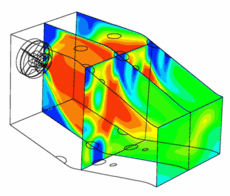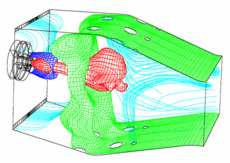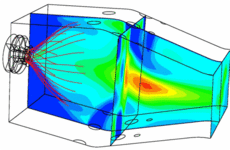steady-state turbulent diffusion flames
Example: swirling flame in a jet engine combustors
Under the Engine 3E project, which is part of the German national aeronautical research program, MTU Aero Engines, University of Karlsruhe and DLR Aerospace Research Centre cooperate in the research and development of low-emission aero engines. The program focuses on a high-bypass turbofan engine. Part of the program is dedicated to the development of a low-emission single-annular combustor that reduces NOx emission through improved homogenization of the air-fuel mixture in the combustor.
To achieve NOx reduction, a rich-lean combustion process was selected. A reduction in NOx emissions through rich-lean combustion can be achieved by preventing stoichiometric combustion, i.e. by splitting the combustion cycle into a fuel-rich stage (low-oxygen zone) and a fuel-lean stage (low-temperature zone). The NOx reduction capability of this combustor increases as the homogeneity of the mixture in the rich stage improves and the mixing velocity in the quench module, where the transition from rich to lean combustion occurs, quickens.
The performance and quality of different mathematical models described was studied by predicting the reacting flow field of a
swirl stabilized combustor. The combustor chosen for this study was extensively investigated within the research program Engine3E.
In the study, a modified version of the standard k-e model was used to represent the turbulent swirling flow. An Eulerian model was used to represent the fluid phase of the fuel. Within this method the spray is considered as a continuum which is represented analogously to single phase flows by a set of transport equations. This description allows the gaseous phase and the spray to be discretized by the same method and ,therefore, to be solved by the same numerical procedure. This approach promises to be more efficiently in terms of computational effort when predicting strongly interacting two-phase flows. For the two-phase calculations dodecane was used to represent the fuel.
For the prediction of heat release, two different reaction models have been used. In the first stage, theeddy dissipation model which is valid for ''mixed=burned'' flame regimes was used. As swirling flames usually comprise highly turbulent flows, the interaction of turbulence and chemical reactions has to be consideredcarefully. Due to computational limitations, the chemistry model has to be restricted to very few reaction progress variables. Therefore, in the second stage a presumed-shape-PDF (JPDF) model was applied.
The pictures show some typical results of the flow and mixing filed, the temperature field and the NOx-distribution.
 |
 |
 |
References (siehe Einträge 3,4,5,6 in Literaturliste):
Zarzalis, N., Ripplinger, T., Hohmann, S., Hettel, M., Merkle, K., Leuckel, W., Klose, G., Meier, R., Koch, R., Wittig, S., Carl, M., Behrendt, T., Hassa, C., Meier, U., Lückerath, R., Stricker, W., (2002). Low-NOx Combustor Development national research program in a cooperative effort among engine Manufacturer MTU, University of Karlsruhe and DLR German Aerospace Research Center. Aerospace Science and Technology, 6, 531-544.
Klose, G., Hettel, M., Zarzalis, N., Schmehl, R., Meier, R., Maier, G., Koch, R., Leuckel, W., Wittig, S., (2001). Evaluation of Advanced Two-Phase Flow and Combustion Models for Predicting Low Emission Combustors. Transactions of the ASME, Journal of Engineering for Gas Turbines and Power, 123, 817-823.
Hettel, M., Leuckel, W., Klose, G., Schmehl, R., Meier, R., Maier, G., Koch, R., Wittig, S., Zarzalis, N., Hohmann, S., (2000). Evaluierung fortschrittlicher Modelle zur Berechnung von Zweiphasenströmungen, in DGLR-Jahrbuch 2000, Deutscher Luft- und Raumfahrtkongress, 18.-21.9. 2000, Leipzig.
Klose, G., Hettel, M., Zarzalis, N., Schmehl, R., Meier, R., Maier, G., Koch, R., Leuckel, W., Wittig, S., (2000). Evaluation of Advanced Two-Phase Flow and Combustion Models for Predicting Low Emission Combustors (Paper: 2000-GT-0133), in Proceedings of ASME Turbo Expo 2000, 45th ASME Gas Turbine & Aeroengine Congress, ASME, May 8th-11th, Munich, Germany.
